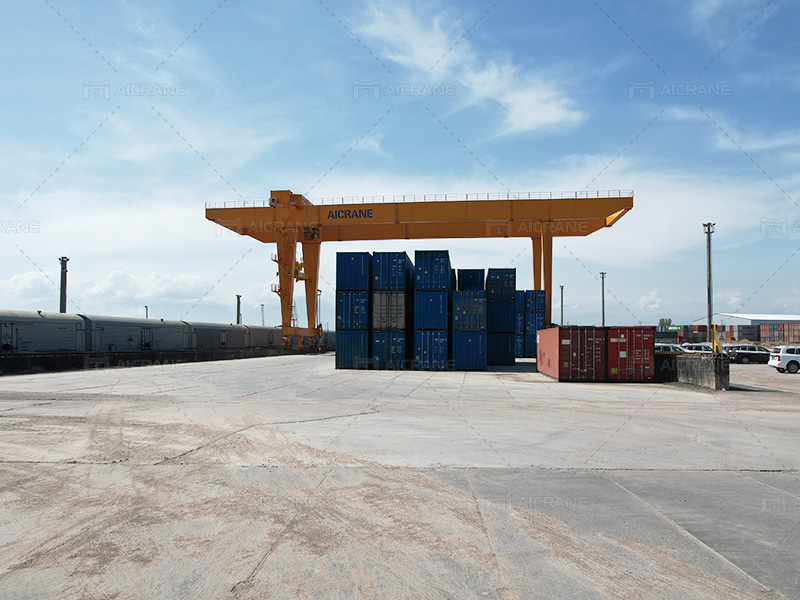In the realm of container handling, Rapid Mounted Gantry (RMG) cranes play a pivotal role due to their efficiency, precision, and robustness. These cranes are engineered to handle heavy loads and facilitate the stacking and transportation of containers in ports, rail yards, and intermodal facilities. This article delves into the typical specifications of RMG cranes and explores the various power systems that drive these crucial machines.

Typical Specifications of RMG Cranes
RMG cranes are known for their impressive specifications, which make them indispensable in container terminals. Here are some of the key specifications that characterize these cranes:
1. Span and Lifting Capacity: RMG cranes are designed to span large distances, often up to 50 meters. This expansive span allows them to cover multiple rows of containers, enhancing the efficiency of container handling operations. In terms of lifting capacity, rail mounted gantry cranes are built to handle loads ranging from 20 to 65 tons. This high lifting capacity ensures that even the heaviest containers can be moved with ease.
2. Lifting Height: The lifting height of an RMG crane is another critical specification. These cranes typically offer lifting heights of up to 40 meters. Such significant lifting heights are necessary to stack containers in multiple tiers, optimizing the use of available space in container yards.
3. Hoisting Speed: Hoisting speed is a vital parameter, as it determines how quickly containers can be lifted and lowered. RMG cranes usually have hoisting speeds ranging from 20 to 60 meters per minute, depending on the model and specific application requirements. Faster hoisting speeds translate to quicker loading and unloading times, improving overall terminal efficiency.
4. Trolley Speed: The speed at which the trolley moves horizontally along the span of the crane is also crucial. RMG cranes typically have trolley speeds of 70 to 150 meters per minute. This speed facilitates the rapid positioning of the crane over containers, reducing idle time and increasing throughput.
5. Gantry Travel Speed: Gantry travel speed refers to the movement speed of the entire crane along its rail tracks. Typical gantry travel speeds for RMG cranes range from 45 to 120 meters per minute. This speed is essential for swiftly relocating the crane to different rows of containers, enhancing operational flexibility.
6. Control Systems: Modern RMG cranes are equipped with advanced control systems that include features like anti-sway mechanisms, automatic positioning, and remote operation capabilities. These control systems ensure precision in container handling, minimize human error, and enhance safety.
7. Environmental Adaptability: RMG cranes are designed to operate in various environmental conditions. They are built to withstand harsh weather, including high winds, extreme temperatures, and corrosive marine environments. Robust construction materials and protective coatings ensure longevity and reliability.

How RMG Cranes are Powered
The power systems of RMG cranes are integral to their operation, affecting efficiency, environmental impact, and operational costs. RMG cranes are typically powered by electricity, which offers several advantages over other power sources. Here’s a closer look at the power systems that drive RMG cranes:
1. Electric Power Supply: RMG cranes are predominantly powered by electricity, which is supplied either through a direct connection to the grid or through battery systems. The choice between these options depends on the specific operational requirements and infrastructure of the container terminal.
2. Direct Grid Connection: When connected directly to the electrical grid, RMG cranes draw power through a cable reel or conductor bar system. This setup ensures a continuous and reliable power supply, allowing the crane to operate without interruptions. The main benefits of a direct grid connection include:
- Consistent Power Supply: Ensures uninterrupted operations, essential for high-traffic terminals.
- Lower Operational Costs: Electricity from the grid is generally more cost-effective compared to diesel or other fuels.
- Reduced Emissions: Electric power minimizes the carbon footprint and reduces air pollution compared to diesel-powered cranes.
3. Battery Systems: In scenarios where a direct grid connection is not feasible, RMG container gantry cranes can be equipped with battery systems. These systems provide several benefits:
- Flexibility: Battery-powered RMG cranes can operate independently of fixed power infrastructure, offering greater flexibility in yard layout.
- Reduced Emissions: Like grid-connected systems, battery-powered cranes produce lower emissions compared to diesel alternatives.
- Energy Efficiency: Advances in battery technology have led to improved energy storage and efficiency, making this option increasingly viable.
4. Hybrid Systems: Some RMG cranes utilize hybrid power systems that combine grid electricity with battery storage. This approach offers the best of both worlds, ensuring continuous operation even during power outages and reducing peak electricity demand. Hybrid systems can also incorporate regenerative braking, where the energy generated during braking is stored in the batteries for later use, further enhancing energy efficiency.
5. Energy Management Systems: Modern RMG cranes are equipped with sophisticated energy management systems that optimize power usage. These systems can monitor energy consumption, predict peak loads, and manage the charging and discharging cycles of battery systems. By optimizing energy usage, these systems help reduce operational costs and extend the lifespan of the crane’s components.
6. Green Technologies: In line with global trends towards sustainability, some RMG cranes are being designed to incorporate renewable energy sources. Solar panels and wind turbines can be integrated into the crane’s infrastructure to provide supplemental power, further reducing reliance on non-renewable energy sources and minimizing environmental impact.
Conclusion
RMG cranes are a cornerstone of modern container handling operations, offering high efficiency, precision, and flexibility. Their typical specifications, such as wide spans, high lifting capacities, and advanced control systems, make them suitable for the demanding environments of ports and container terminals. The shift towards electric power systems, whether through direct grid connections, battery systems, or hybrid approaches, underscores the industry’s commitment to sustainability and efficiency. As technology advances, RMG cranes are poised to become even more integral to the logistics and transportation sectors, driving progress and innovation in container handling.